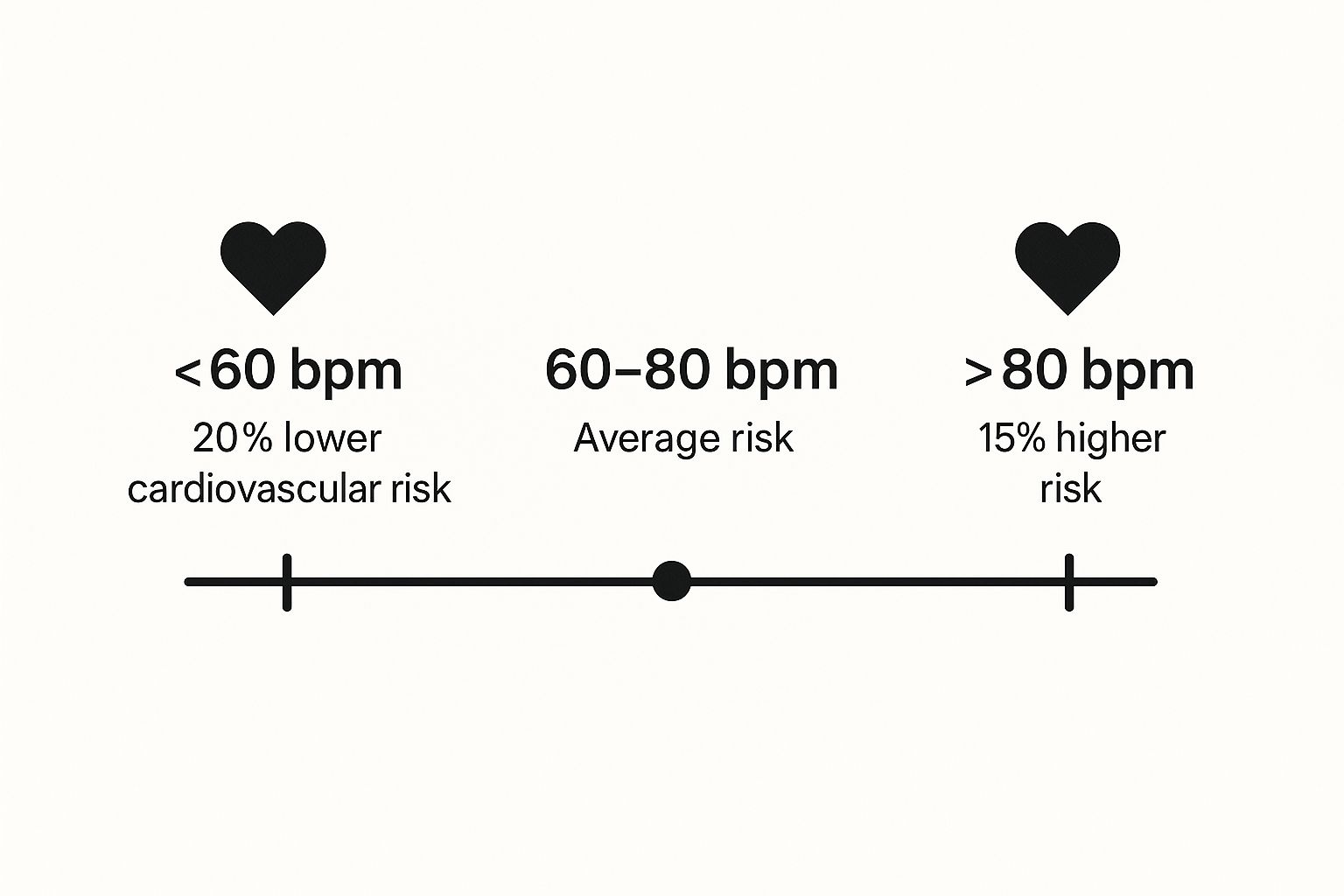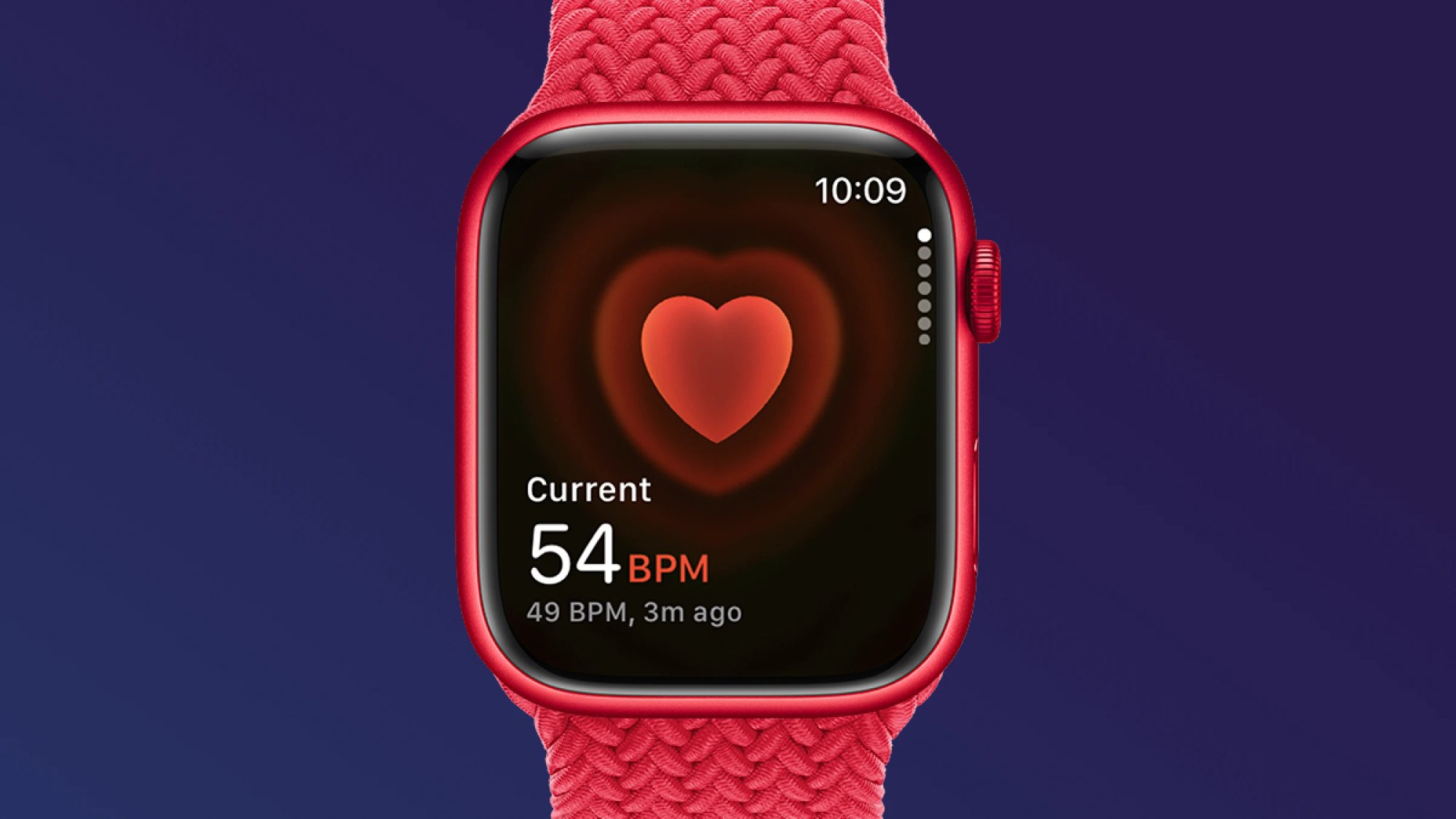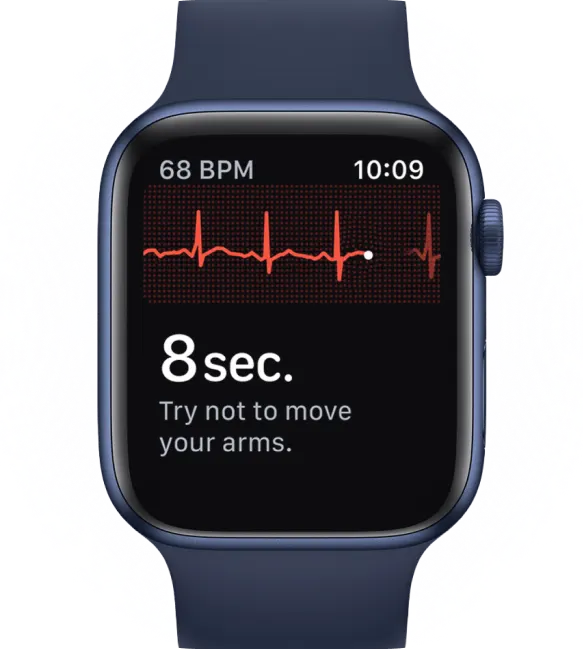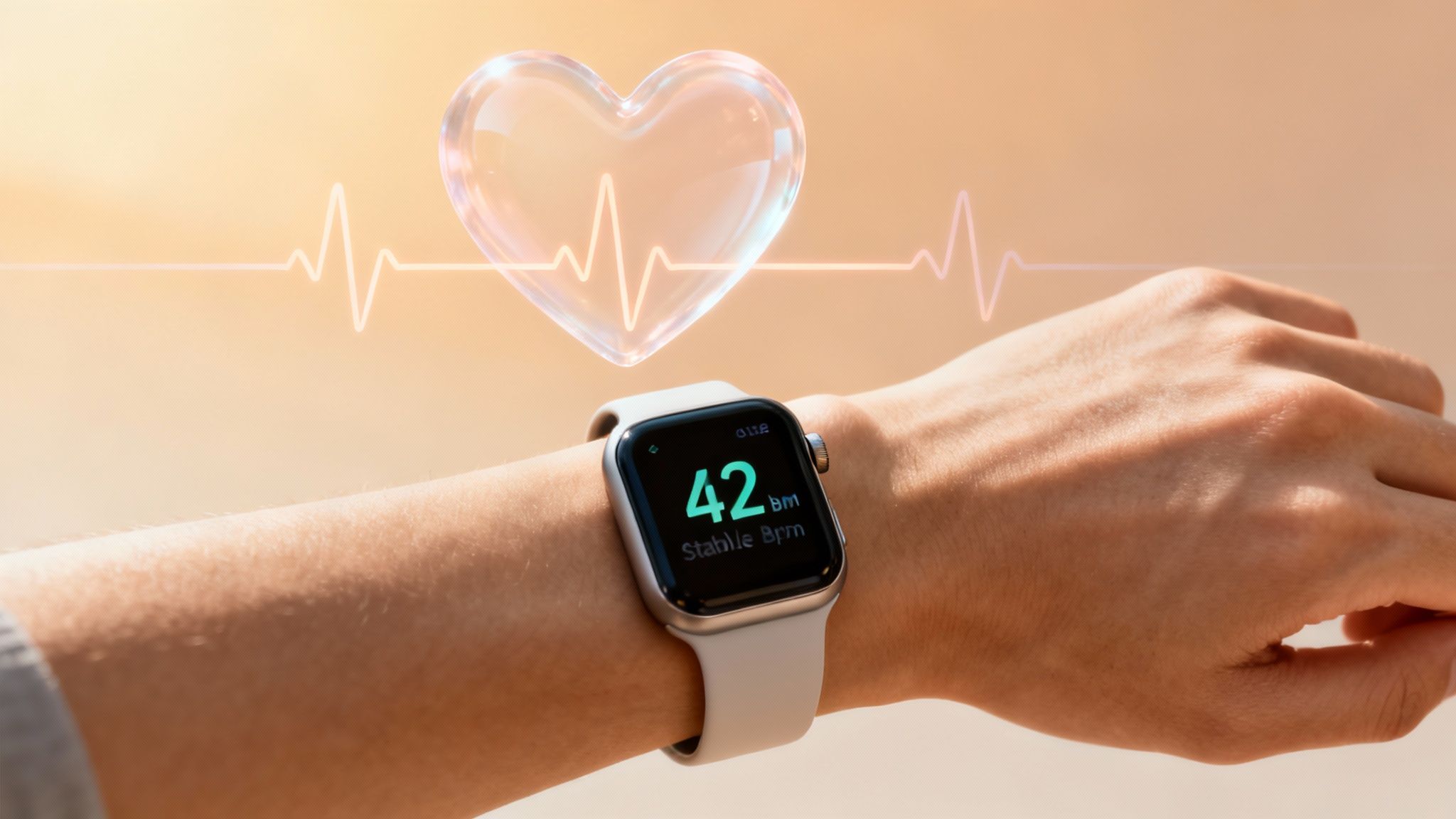Key Takeaways
Hello Heart Hero. A normal resting cardiac rate for most adults lands somewhere between 60 and 100 beats per minute (bpm). You can think of it as your heart's baseline speed when you're calm and relaxed. It’s a key indicator of your heart’s overall efficiency.
Welcome to Your Heart Health Journey

We get it. Trying to navigate the world of health information can feel like a lot, especially when it comes to something as vital as your heart. You might feel let down by generic advice and are looking for clear, trustworthy answers that actually make sense for you. That’s exactly why we created this guide.
Understanding your heart rate is the first real step toward taking charge of your heart health. The widely accepted range of 60 to 100 bpm has been a stable guideline across major health organizations for decades. This standard is recognized all over the world, from the United States to Europe and Australia.
Think of your resting heart rate like a car's engine at idle. A healthy, efficient engine runs smoothly without having to rev too high. In the same way, a strong heart doesn't need to work overtime to pump blood when your body is at rest.
What Is a Normal Heart Rate for You?
While that 60 to 100 bpm range is a great starting point, what’s "normal" can definitely change throughout your life. For instance, a baby’s heart beats much faster than a teenager’s, and a trained athlete’s resting rate might be significantly lower than average.
To give you a practical reference, we've put together a simple table that shows how these numbers typically evolve at different stages of life.
Normal Resting Cardiac Rates by Age Group
Here’s a quick reference guide showing the typical resting heart rate ranges for different stages of life.
As you can see, our heart rates naturally slow down and stabilize as we move from infancy into adulthood.
Why Your Resting Heart Rate Matters
Think of your resting heart rate as a quiet messenger from your heart, giving you daily updates on its overall health and efficiency. It’s not just a number, it’s a powerful window into your cardiovascular fitness. A lower resting heart rate (within the normal range) often means you have a stronger, more efficient heart muscle.
It’s like a well-tuned car engine that runs smoothly without having to work too hard. A fit heart can pump more blood with each beat, so it doesn't need to beat as often to supply your body with the oxygen it needs. This efficiency puts less strain on your heart over time and is a cornerstone of long-term wellness.
A consistently lower resting heart rate is one of the clearest indicators of a healthy cardiovascular system. It reflects your body's ability to handle stress, recover from activity, and function optimally day-to-day.
Understanding this simple metric is empowering. It allows you to take a more active role in your health journey, rather than just waiting for doctor's appointments to get answers.
What Your Heart Rate Reveals About Longevity
The connection between your resting heart rate and your lifespan is pretty compelling. For example, the Copenhagen City Heart Study revealed that men with a resting heart rate of 65 bpm lived 4.6 years longer on average than those with a rate of 80 bpm. For women, the difference was 3.6 years, which really highlights how important heart monitoring can be.
This infographic breaks down how different resting heart rate ranges are linked to cardiovascular risk.

As you can see, keeping your resting heart rate below 80 bpm, and ideally closer to 60 bpm, is associated with lower long-term risk. Watching your own trends gives you valuable feedback on how your lifestyle choices are working. And if you're looking to actively improve this metric, check out our guide on how to lower your resting heart rate.
How Your Heart Rate Changes Over Time

It’s completely normal to wonder if your heart rate is “right.” But the truth is, what’s normal is a moving target that changes throughout your life. Your heart rate isn't a single, static number; it’s a dynamic part of your personal health story, evolving as you grow from a baby into an adult.
This journey begins right at birth. A newborn’s heart beats incredibly fast, and that’s actually a sign of a healthy, developing body. As a child grows, their heart and cardiovascular system mature, becoming stronger and more efficient.
Think of it like a young tree growing deep roots; as it strengthens, it needs less frantic energy to thrive. Your heart does something very similar. This gradual slowing is a natural process, and understanding it can help you make sense of your own numbers without unnecessary alarm.
From Infancy to Adulthood
The most dramatic shifts in your normal heart rate happen during your earliest years. A newborn’s heart can beat as fast as 205 bpm. That's a number that would be alarming for an adult but is perfectly healthy for them. From there, the rate steadily decreases through childhood.
- Newborns (0–1 month): The highest normal rates, often between 100 and 205 bpm.
- Preschoolers (3–5 years): The range drops significantly to 80–120 bpm.
- Adolescents: The rate settles into the familiar adult range of 60–100 bpm.
This physiological shift is a beautiful example of your body adapting as it matures. You can learn more about these age-based heart rate ranges and the science behind them.
Remember, your heart rate is a personal benchmark. What is healthy for a five-year-old is very different from what is healthy for you, and that’s exactly how it should be.
This natural slowing down is a sign of increasing cardiac efficiency. However, if an adult’s heart rate is too slow, a condition known as bradycardia, it can sometimes signal other issues, especially if it comes with symptoms like dizziness. To understand this better, check out our guide on what causes bradycardia.
Everyday Factors That Influence Your Heart Rate
Your heart is incredibly responsive, and its rhythm constantly changes based on what you’re doing, thinking, and feeling. It’s a mistake to think of your heart rate as one fixed number. Instead, view it as a dynamic reflection of your daily life. It's completely normal for it to speed up or slow down in response to countless everyday triggers.
Understanding these influences is the key to making sense of your heart rate data without jumping to worried conclusions. Most of the time, temporary fluctuations are just your body’s way of adapting. Things like your emotional state, physical activity, and even what you eat and drink can cause noticeable and perfectly normal changes.
For instance, a stressful work presentation can send your heart rate climbing, while a few minutes of quiet meditation can bring it right back down. That’s your nervous system doing its job, either preparing your body for action or letting it rest and recover.
Common Influencers on Your Cardiac Rate
Many daily habits and conditions can temporarily shift your normal heart rate. Your morning coffee, for instance, contains caffeine, a stimulant that gives many of us a much-needed boost but can also cause a short-term spike in heart rate. If you're curious about this, you can learn more by examining coffee's impact on your heart.
Emotions are another powerful driver. Feelings of stress or anxiety trigger the release of hormones like adrenaline, which signals your heart to beat faster. This is a classic "fight-or-flight" response. On the flip side, simple relaxation techniques can be powerful tools for managing this response. Learning a few effective breathing exercises for anxiety can make a real difference in stabilizing your heart rate during tense moments.
Seeing your heart rate change throughout the day is a sign that your body is actively responding to your life. The goal isn’t a flat line; it’s understanding the patterns behind the peaks and valleys.
To help you connect the dots between your lifestyle and your heart's behavior, the table below breaks down some of the most common factors that can affect your heart rate.
Common Factors Affecting Your Heart Rate
Keeping these factors in mind will give you a much clearer picture of what your heart rate data is telling you and help you distinguish between a normal daily fluctuation and something worth paying closer attention to.
How to Monitor Your Heart Rate at Home

Taking charge of your own health is a powerful feeling, and your heart rate is one of the best places to start. The good news? You don’t need any fancy gadgets for a quick check-in. The ability to find and read your own pulse is a fantastic skill to have.
This simple, old-school technique gives you a real-time snapshot of what your heart is doing. It’s a direct connection to your body’s most essential rhythm, offering instant insight without having to wait for an appointment.
Checking Your Pulse Manually
The easiest and most common places to find your pulse are on your wrist and the side of your neck. This is because major arteries run very close to the skin's surface in these spots.
Here's how to do it:
- Find Your Pulse: Gently place two fingers, your index and middle fingers work best, on the inside of your wrist, just below the base of your thumb. You can also place them on your neck, to the side of your windpipe. It's best to avoid using your thumb, as it has its own faint pulse that can throw off your count.
- Count the Beats: Once you feel that steady thump-thump, start counting. Keep track of how many beats you feel over 30 seconds.
- Calculate Your Rate: Take the number of beats you counted and simply double it. That's your heart rate in beats per minute (bpm).
Checking your pulse is about more than just getting a number; it’s about becoming more aware of your body's signals. This personal connection is a key part of taking a proactive role in your own health.
While the manual method is great for a spot-check, modern tools like smartwatches and ECG monitors can give you a more continuous and detailed picture of your heart's activity. To learn more about these options, check out our guide on how to check heart health at home.
Your Heart Health Is a Journey Not a Number
We've covered a lot of ground together, from figuring out what a "normal" heart rate is to exploring how you can keep an eye on it yourself. If you take away just one thing, let it be this: your heart health is a deeply personal journey, and a single number rarely tells the whole story.
The goal isn't to obsess over hitting a "perfect" heart rate. It’s about getting to know your body's unique rhythm and seeing how your numbers trend over time. This is how you learn what’s normal for you.
On this journey, knowledge is your best friend. It helps turn that flutter of anxiety you might feel into real confidence about your health.
Remember, the standard 60 to 100 bpm range for an adult is just a guideline, not a hard-and-fast rule. Your actual "normal" is shaped by everything from your age and fitness level to your daily stress, making your personal trends far more insightful than any single reading.
Often, a lower resting heart rate is a fantastic sign of good cardiovascular fitness. When you understand your own heart rate and what influences it, you're in a much better position to have productive, informed conversations with your doctor. This knowledge gives you the power to make choices that truly support your long-term well-being and gives you some well-deserved peace of mind along the way.
Common Questions About Heart Rate
Let's tackle some of the most common questions that come up about heart rate. Think of this as your quick-start guide for the topics you're curious about, so you can feel more confident reading your body's signals.
Is a Resting Heart Rate Below 60 BPM a Bad Thing?
Not always. For athletes and people who are very active, a resting heart rate below 60 bpm is often a sign of a strong, efficient heart. This condition is called bradycardia. A well-conditioned heart can pump more blood with every beat, meaning it doesn't need to beat as often when you're resting.
But context is key. If you have a low heart rate and you're also feeling dizzy, faint, or unusually tired, that's a different story. It’s always best to chat with your doctor in that situation, just to make sure everything's okay.
What's a Good Heart Rate During Exercise?
Your target heart rate for a workout is unique to you, and it’s mostly based on your age. There's a quick way to estimate your maximum heart rate: just subtract your age from 220. Once you have that number, you can figure out your target zones.
- Moderate exercise: Aim for 50-70% of your maximum heart rate.
- Vigorous exercise: Aim for 70-85% of your maximum.
For instance, if you're 40 years old, your estimated maximum heart rate is 180 bpm. For a moderate workout, your sweet spot would be between 90 and 126 bpm. Remember, this is just a guideline. The golden rule is to always listen to what your body is telling you.
When Should I Be Worried About My Heart Rate?
It's a good idea to talk to a doctor if your resting heart rate is consistently over 100 bpm (tachycardia) or stays below 60 bpm (and you're not an active person). Pay extra attention if those numbers show up alongside other symptoms.
Your body is pretty good at telling you when something's off. Symptoms like shortness of breath, dizziness, chest pain, or a fluttering or skipping sensation in your chest are clear signals to get a professional opinion.
At the end of the day, nobody knows your body better than you do. Trust your gut. If something feels off, getting it checked out is one of the best things you can do for your health and your peace of mind.
Take the guesswork out of interpreting your ECGs. With Qaly, you can get your wearable ECG readings analyzed by certified experts within minutes, any time of day. Understand what your heart is telling you and gain the peace of mind you deserve by visiting https://www.qaly.co.
Heart feels off? Get your ECGs read by certified experts within minutes, for peace of mind ❤️










.png)
.png)